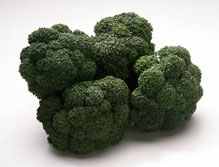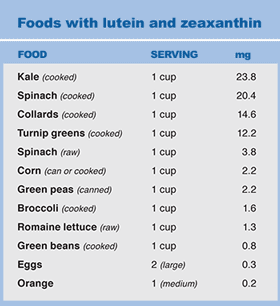Lutein & Zeaxanthin
 Lutein (LOO-teen) and zeaxanthin are important nutrients found in green leafy vegetables as well as other foods such as eggs. Many studies have shown that lutein and zeaxanthin reduce the risk of chronic eye diseases, including age-related macular degeneration (AMD) and cataracts.
Lutein (LOO-teen) and zeaxanthin are important nutrients found in green leafy vegetables as well as other foods such as eggs. Many studies have shown that lutein and zeaxanthin reduce the risk of chronic eye diseases, including age-related macular degeneration (AMD) and cataracts. AMD and cataract incidence are growing. Worldwide, more than 25 million people are affected by age-related macular degeneration and the formation of cataracts. AMD is the leading cause of blindness in people over age 55 in the Western world and the incidence is expected to triple by 2025.
Benefits to Eye Health
Lutein and zeaxanthin are carotenoids that filter harmful high-energy blue wavelengths of light and act as antioxidants in the eye, helping protect and maintain healthy cells. Of the 600 carotenoids found in nature, only two are deposited in high quantities in the retina (macula) of the eye: lutein and zeaxanthin. The quantity of lutein and zeaxanthin in the macular region of the retina can be measured as macular pigment optical density (MPOD). Recently, MPOD has become a useful biomarker for not only predicting disease but also visual function. Unfortunately, the human body does not synthesize the lutein and zeaxanthin it needs, which is the reason why green vegetables are essential to good nutrition. Daily intake of lutein and zeaxanthin through diet, nutritional supplements, or fortified foods and beverages is important for the maintenance of good eye health.
Lutein, Zeaxanthin and Cataracts
The primary function of the crystalline lens (or natural lens in the eye) is to collect and focus light on the retina. To properly provide this function throughout life, the lens must remain clear. Oxidation of the lens is a major cause of cataracts, which cloud the lens. As antioxidant nutrients neutralize free radicals (unstable molecules) associated with oxidative stress and retinal damage, lutein and zeaxanthin likely play a role in cataract prevention. In fact, a recent study demonstrated that higher dietary intakes of lutein and zeaxanthin and vitamin E was associated with a significantly decreased risk of cataract formation.
Lutein, Zeaxanthin and Age-Related Macular Degeneration
Much evidence supports the role of lutein and zeaxanthin in reducing the risk of AMD. In fact, The National Eye Institute presently is conducting a second large human clinical trial, Age-Related Eye Disease Study (AREDS2), to confirm whether supplements containing 10 mg a day of lutein and 2 mg of zeaxanthin per day affect the risk of developing AMD. Beyond reducing the risk of developing eye disease, separate studies have shown that lutein and zeaxanthin improve visual performance in AMD patients, cataract patients and individuals with good health.
Daily Intake*

Although there is no recommended daily intake for lutein and zeaxanthin, most recent studies show a health benefit for lutein supplementation at 10 mg/day and leaxanthin supplementation at 2 mg/day.
Food Sources
Most Western diets are low in lutein and zeaxanthin, which can be found in spinach, corn, broccoli and eggs. The following table lists foods known to be high in lutein and zeaxanthin. If you are not getting enough lutein and zeaxanthin through diet alone, consider adding supplements to your daily routine.
References
- (2001). "A randomized, placebo-controlled, clinical trial of high-dose supplementation with vitamins C and E, beta carotene, and zinc for age- related macular degeneration and vision loss: AREDS report no. 8." Arch Ophthalmol 119(10): 1417-36.
- Seddon, J. M., et al. (1994). "Dietary carotenoids, vitamins A, C and E, and advanced age-related macular degeneration. Eye Disease Case Control Study Group.” JAMA 272(18): 1413-20.
- Christen, W.G., S. Liu, et al . (2008). “Dietary carotenoids, vitamins C and E, and risk of cataract in women: a prospective study.” Archives of Ophthalmology 126(1): 102-9.
- Stahl and Sies (2005) “Bioactivity and protective effects of natural carotenoids.” Biochimica et Biophysica Acta. 1740:101-107.
- Richer, S., W. Stiles, et al. (2004). "Double-masked, placebo-controlled, randomized trial of lutein and antioxidant supplementation in the intervention of atrophic age-related macular degeneration: the Veterans LAST study (Lutein Antioxidant Supplementation Trial)." Optometry 75(4): 216-30.
- Stringham, J. M. and B. Hammond (2008). "Macular Pigment and Visual Performance Under Glare Conditions." Optometry & Vision Science 85(2): 82-88.
- Chew, E. (2007). “Age-related eye disease study 2 protocol.” National Eye Institute Protocol 07-EI-0025.
- U.S. Department of Agriculture, Agricultural Research Service, USDA Nutrient Data Laboratory. USDA National Nutrient Database for Standard Reference, Release 20 (2007). Nutrient Data Laboratory Home Page, http://www.nal.usda.gov/fnic/foodcomp
- (1993). "Antioxidant status and neovascular age-related macular degeneration. Eye Disease Case-Control Study Group." Arch Ophthalmol 111(1): 104-9.
- Lyle, B. J., J. A. Mares-Perlman, et al. (1999). "Antioxidant intake and risk of incident age-related nuclear cataracts in the Beaver Dam Eye Study." Am J Epidemiol 149(9): 801-9.
- Kvansakul, J., M. Rodriguez-Carmona, et al. (2006). “Supplementation with the carotenoids lutein or zeaxanthin improves human visual performance.” Ophthalmic Physiol Opt 26(4): 362-71.
- Parisi, V., M. Tedeschi, et al. (2008). “Carotenoids and antioxidants in age-related maculopathy italian study: multifocal electroretinogram modifications after 1 year.” Ophthalmology 115(2): 324-333.
*At this time, the AOA is unaware of any studies that have examined interactions between medications and lutein and zeaxanthin. The AOA also is not aware of any adverse health reports from interactions between medications and lutein and zeaxanthin. However, the AOA recommends consulting with a health care professional before beginning any supplementation regiment.
